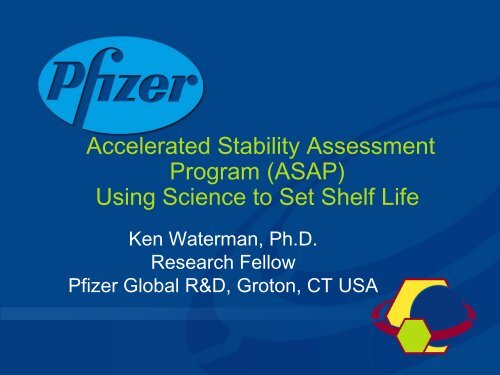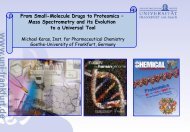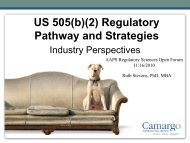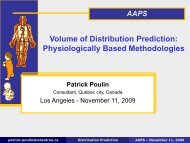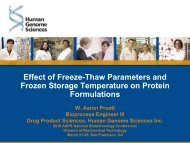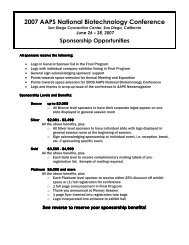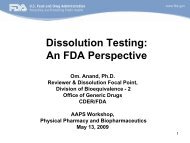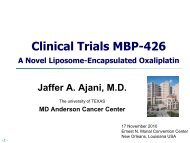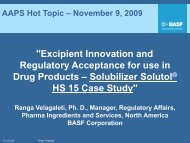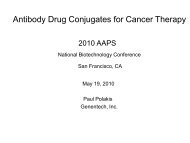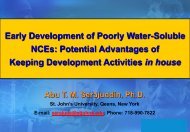Accelerated Stability Assessment Program (ASAP) - American ...
Accelerated Stability Assessment Program (ASAP) - American ...
Accelerated Stability Assessment Program (ASAP) - American ...
- No tags were found...
You also want an ePaper? Increase the reach of your titles
YUMPU automatically turns print PDFs into web optimized ePapers that Google loves.
<strong>Accelerated</strong> <strong>Stability</strong> <strong>Assessment</strong><strong>Program</strong> (<strong>ASAP</strong>)Using Science to Set Shelf LifeKen Waterman, Ph.D.Research FellowPfizer Global R&D, Groton, CT USA
Outline• Background and Scope• Heterogeneous Kinetics and Isoconversion• Moisture Sensitivity• <strong>ASAP</strong> Experimental Design• Packaging• Regulatory Considerations• Conclusions2
<strong>Accelerated</strong> <strong>Stability</strong> <strong>Assessment</strong><strong>Program</strong> (<strong>ASAP</strong>)• Modeling tool that improves product understanding• Credible predictions for product expiration dating– Reduces uncertainty– Has the potential to change the way industry meets its stabilitycommitments• Clinical investigations• Registration• Annual review• Post-Approval Changes• Scope– Solid drug products– Solid API’s– Small molecules3
Heterogeneous Kinetics for SolidsAPIOverallproductexcipientAPI/excipientinterfaceInside crystal molecules4
log kExcipient/API Interactions-0.6-0.8-1-1.2-1.4-1.6Power Law relation for API +excipients: more surfaceinteractions---more reactivity0 0.5 1 1.5 2 2.5log (100/%API)Aspirin tablets at 40ºC/75%RH5
%Degradant<strong>Stability</strong> at Different Temperatures1.41.210.80.60.40.200 100 200 300 400 500 600Low TemperatureHigh Temperature0 10 20 30 40 50 60Relative TimeSame curvature independent of T6
<strong>Stability</strong> at Different Temperatures:Historical Approach60 Days at low or high T600 100 200 300 400 500 600Low THigh Tk
<strong>Stability</strong> at Different Temperatures:<strong>ASAP</strong> (Isoconversion) Approach0 100 200 300 400 500 600High TLow T<strong>ASAP</strong> approach: % degradant fixed atspecification limit, time adjusted as needed8
80CArrhenius Plot:Two Approaches70C 60C 50C30CisoconversionCP-456,773/60%RHHistorical method: highT deviations give nonlinearbehaviorReal time dataPredicted Shelf Life (historical method)Predicted Shelf Life (<strong>ASAP</strong>/isoconversion)Experimental Shelf Life0.5 yrs1.2 yrs1.2 yrs9
Humidity Corrected Arrhenius Equationcollision frequencyhumidity sensitivity factor1.986 cal/degln k = ln A - E a/(RT) + B(ERH)1/(isoconversion time)equilibrium relative humidityactivation energy10
Aspirin Tablet Degradation70C50C 40C 30C20C75% RH10%RHParallel Arrhenius curves seen at each RH11
Typical E a and B values (n=60)29.80.043RH sensitivity does not indicate hydrolysis!12
Effect of B Values on Shelf Life (Constant T)B0.00low moisturesensitivity0.04average moisturesensitivity0.09high moisturesensitivity60%RH inPVCBlister65%RH inPVCBlister75%RH inPVCBlister60%RH inBottle +Desiccant5.0 yrs 5.0 yrs 5.0 yrs 5.0 yrs5.0 yrs 3.8 yrs 2.6 yrs 7.1 yrs5.0 yrs 3.0 yrs 1.2 yrs 8.8 yrs13
Effect of Activation Energies on Shelf Life(Constant RH)Shelf-Life (years)E a(kcal/mol) 25C 30C 40C12 Low activation energy 5.0 3.6 1.929 Average activation energy 5.0 2.2 0.539 High activation energy 5.0 1.7 0.214
<strong>ASAP</strong> Screening-Protocol: Set to GenerateSpecification Levels GenericallyProtocol T (C) %RH Days50 75 1460 40 14Drug Product70 5 14<strong>Stability</strong> Screen70 75 180 40 2Actual protocol is product-specific!15
<strong>ASAP</strong> Design Space (DOE)ln k = ln A - E a /R(1/T) + B(%RH)ln k%RH70/7580/4060/4050/7540/7530/75Ln A70/ 530/6525/60BE a /R1/T16
Error Bars for Predicted Shelf-Lifeln kShelf-life error bars depend on:•Extrapolation distance•Errors in k’s•Design/degrees of freedom70/75%RH80/4060/4050/75Ln A70/ 525ºC/60%RHB1/TE a /R17
Error Bars for Predicted Shelf-LifeExample: Confidence IntervalFor 2 year shelf life (25ºC/60%RH) = 95%For 3 year shelf life (25ºC/60%RH) = 75%ln k70/75%RH80/4060/4050/75Ln A70/ 525ºC/60%RHB1/TE a /RCalculated using Monte-Carlo simulation process18
Error Bars for Predicted Shelf-Lifeln kExample: Confidence IntervalFor 2 year shelf life (25ºC/60%RH) = 99%For 3 year shelf life (25ºC/60%RH) = 95%70/75%RH80/4060/4050/7540/75Ln A70/ 525ºC/60%RHB1/TE a /R19
Likely Causes for Poor Fit/PredictionForm/Phase change caused by T/RH: melts, glass transitions,anhydrate/hydrate formationln k80/4070/75%RH60/4050/7540/7530/75Ln A30/6525/6070/5BE a /R1/T20
Protocol ExampleFinal protocol may require several iterations!T (C) %RH Days % Degradant50 75 14 0.450.0560 40 14 0.240.0270 5 14 0.090.0270 75 1 0.680.07SpecificationLimit = 0.2%80 40 2 0.590.0625C/60%RH shelf-life (PVC blister)25C/60%RH shelf-life (HDPE bottle)30C/65%RH shelf-life (HDPE bottle)30C/65%RH shelf-life (HDPE bottle, desiccant)2.4-13.2 yrs4.2-18.8 yrs1.8-5.6 yrs3.5-8.8 yrs21
Protocol ExampleFinal protocol may require several iterations!T (C) %RH Days(screeningprotocol)%Degradantusingscreening(generic)protocol50 75 14 0.45 760 40 14 0.24 14Days: Productspecificprotocol70 5 14 0.09 Not tested70 75 1 0.68 Not tested80 40 2 0.59 140 75 Not tested --- 2180 5 Not tested --- 1122
Protocol ExampleFinal protocol may require several iterations!T (C) %RH Days: Protocol 2(productspecific)%Degradant usingproduct specificprotocol40 75 21 0.230.0250 75 7 0.200.0260 40 14 0.220.0280 40 1 0.310.0280 5 11 0.180.0225C/60%RH shelf-life (PVC blister)25C/60%RH shelf-life (HDPE bottle)30C/65%RH shelf-life (HDPE bottle)30C/65%RH shelf-life (HDPE bottle, desiccant)2.9-6.0 yrs5.4-9.4 yrs2.3-3.4 yrs4.3-6.0 yrs23
<strong>ASAP</strong> Protocol ValidationOver 50 drugs have nowbeen studied at Pfizer!24
Packaged-Product <strong>Stability</strong>H 2 OH 2 OH 2 OH 2 OMoisture transfer depends onMVTR + ΔRHMoisture inside packaging equilibratesbetween headspace (RH), tablets,desiccant (vapor sorption isotherms)25
% H 2 OMoisture Sorption Isotherm—Microcrystalline Cellulose1098765432100 20 40 60 80%RH26
%H 2 OMoisture Sorption Isotherm—Desiccants3530252015105010 20 30 40 50 60 70 80%RHSilica GelMolecular SievesClay Mineral27
%RHMoisture Equilibration in Bottle35Tablets introduced3025201510500-mg tablets (2) 1:1 spray-driedlactose:MCC (RH 32%) in N 2 -purged120-cc bottle500 10 20 30 40 50 60 70 80 90Time (min)28
Moisture Vapor Transmission Ratepermeabilitymoisture transferring into a package at a fixeddifference in RH; fixed TP = MVTR/ΔRHdifference in RH inside andoutside packageΔm = P ΔRH Δtmass of waterentering/leavingcontainerunit of time29
MVTR Values• Vary with T inArrhenius manner• Proportional tosurface area• Bottles– 60-cc HDPE (75%RH)• 20C 0.198• 30C 0.534• 40C 1.352– 180-cc HDPE (75%RH)• 30C 1.061• Blisters (30C;75%RH)– Aclar 0.027– PVDC 0.14830
%RHEmpty Bottle/Blister Equilibration6560555045403530Aclar Blister60-cc bottle0 20 40 60 80Days25ºC/60%RH Oven31
%RHBottle/Blister Equilibration with Tablets605550454035300 2 4 6 8 10years25ºC/60%RH Oven60 500-mg tablets 2:1 MCC:lactose60-cc bottle + 60 tabletsAclar blister + 1 tablet32
%RHPredicted (Lines) vs. Measured RH706050empty bottle2 tablets40302010015 tablets15 tablets + desiccant0 10 20 30 40 50 60 70Days500 mg tablets of CP-48171560-cc HDPE Bottles (40C/75%RH)33
%DegradantExample 1: Very Unstable (WhenUnprotected) Drug Product (B = 0.068)4321PVC blister(open bottle)15 tablets/60-ccbottle2 tablets/60-cc bottle15 tablets +desiccant/60-cc bottle00 10 20 30 40 50 60 70DaysLines: predicted (<strong>ASAP</strong> + calculated RH)Diamonds: experimentalCP-481,715 in 60-cc HDPE Bottles (40C/75%RH)34
Example 2: More Stable Drug Product(B = 0.015)Real time<strong>ASAP</strong>Varenicline tablets (500 0.5 mg in 180-cc bottle);30C/65%RH35
<strong>ASAP</strong> vs. Real Time Example 3(25C/60%RH in Bottles with Desiccant)B = 0.022<strong>ASAP</strong>PredictionReal Time36
Bridging Science and Regulations• Early Clinical Trials– Use <strong>ASAP</strong> to support Clinical Use Period assignments• During Development– Use <strong>ASAP</strong> to predict stability for changes in:• Formulations/processes• Synthetic routes• Packaging• At Registration– Use <strong>ASAP</strong> as supportive data or as an alternative to traditional stabilityto minimize stability commitments• Post-Approval– Use <strong>ASAP</strong> to justify changes that will not affect stability– Replace annual commitment with <strong>ASAP</strong> commitment37
Conclusions• <strong>ASAP</strong> provides a scientific basis for setting shelf-lives– Dramatically shorter time– Better understanding– Lower risk• Allows package selection without screening—lowersrisk + saves time38
Acknowledgments• Pfizer scientists Groton and Sandwich• Paul Gerst• Bruce MacDonald• Mike Roy• Anthony Carella• Garry Scrivens39
Related Publications• Waterman, K.C.; MacDonald, B.C. Package selection for moisture protection for solid, oraldrug products, J. Pharm. Sci. 99 (2010) 4437-4452; (on line) DOI 10.1002/jps.22161 (2010)• Waterman, K.C. <strong>Accelerated</strong> stability assessment program (<strong>ASAP</strong>): using science to set shelflife, accepted in <strong>American</strong> Pharm. Rev.• Waterman, K.C. Understanding and predicting pharmaceutical product shelf-life. In Handbookof <strong>Stability</strong> Testing in Pharmaceutical Development: Regulations, Methodologies and BestPractices, Huynhba, K., Ed. Springer Science and Media Publishing, Chapter 6 (2008) 115-135.• Waterman, K.C.; Colgan, S.T. A science-based approach to setting expiry dating for solid drugproducts. Regulatory Rapporteur 5 (2008) 9-14.• Waterman, K.C.; Carella, A.J.; Gumkowski, M.J.; Lukulay, P.; MacDonald, B.C.; Roy, M.C.;Shamblin, S.L. Improved protocol and data analysis for accelerated shelf-life estimation ofsolid dosage forms. Pharmaceutical Research 24 (2007) 780-790.• Waterman, K.C.; Adami, R.C. <strong>Accelerated</strong> aging: prediction of chemical stability ofpharmaceuticals. Intern. J. Pharm. 293 (2005) 101-125.• Waterman, K.C.; Adami, R.C., Hong, J. Impurities in drug products. In Handbook of Isolationand Characterization of Impurities in Pharmaceuticals. S. Ajira and K.M. Alsante, Eds. 2003,pp. 75-85.• Waterman, K.C.; Adami, R.C.; Alsante, K.M.; Antipas, A.S.; Arenson, D.R.; Carrier, R.; Hong,J.; Landis, M.S.; Lombardo, F.; Shah, J.C.; Shalaev, E.Y.; Smith, S.W.; Wang, H. Hydrolysis inpharmaceutical formulations. Pharm. Dev. Tech. 7 (2002) 113-146.• Waterman, K.C.; Adami, R.C.; Alsante, K.M.; Hong, J.; Landis, M.S.; Lombardo, F.; Roberts,C.J. Stabilization of pharmaceuticals to oxidative degradation. Pharm. Dev. Tech. 7 (2002) 1-32.40


